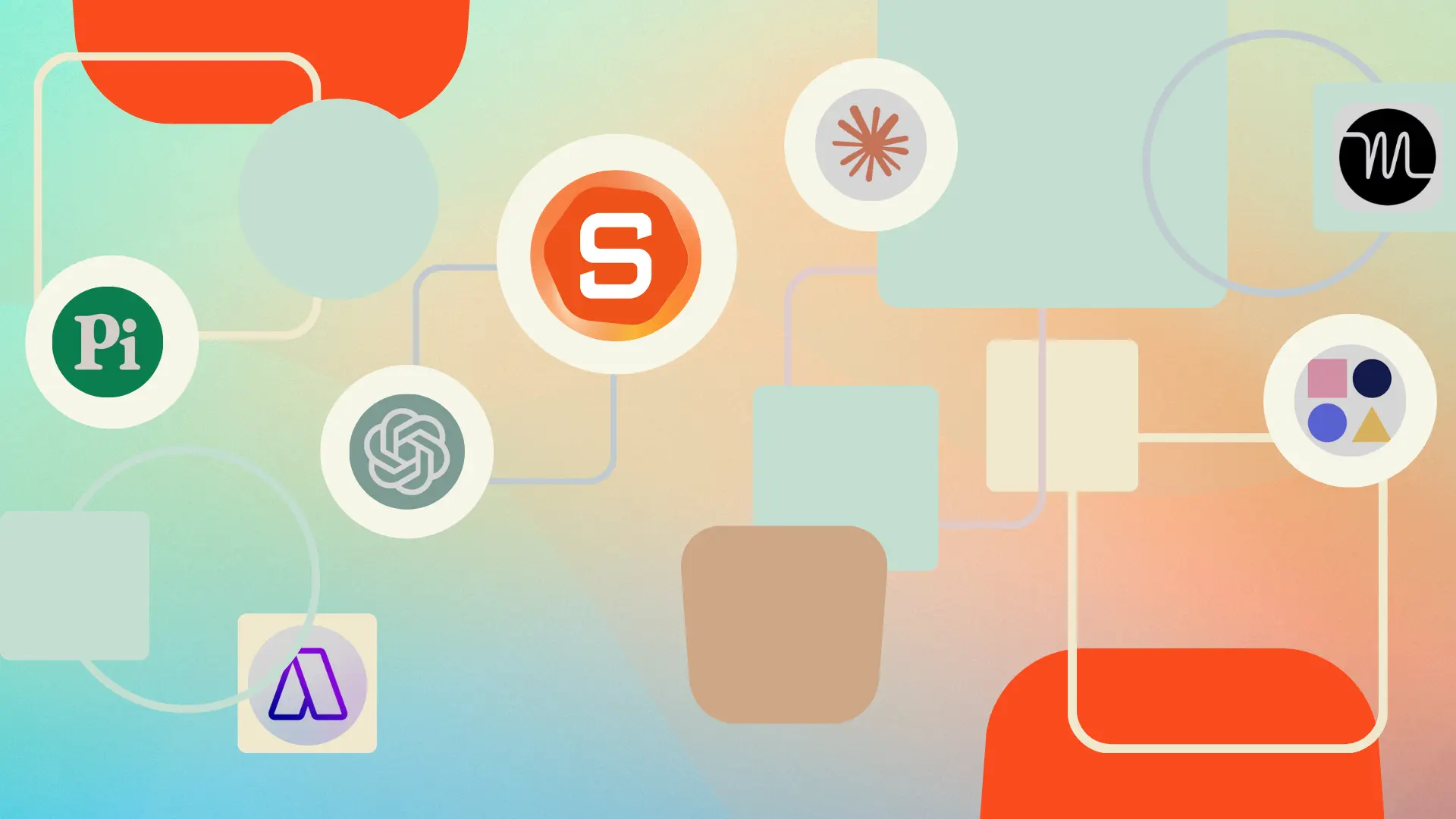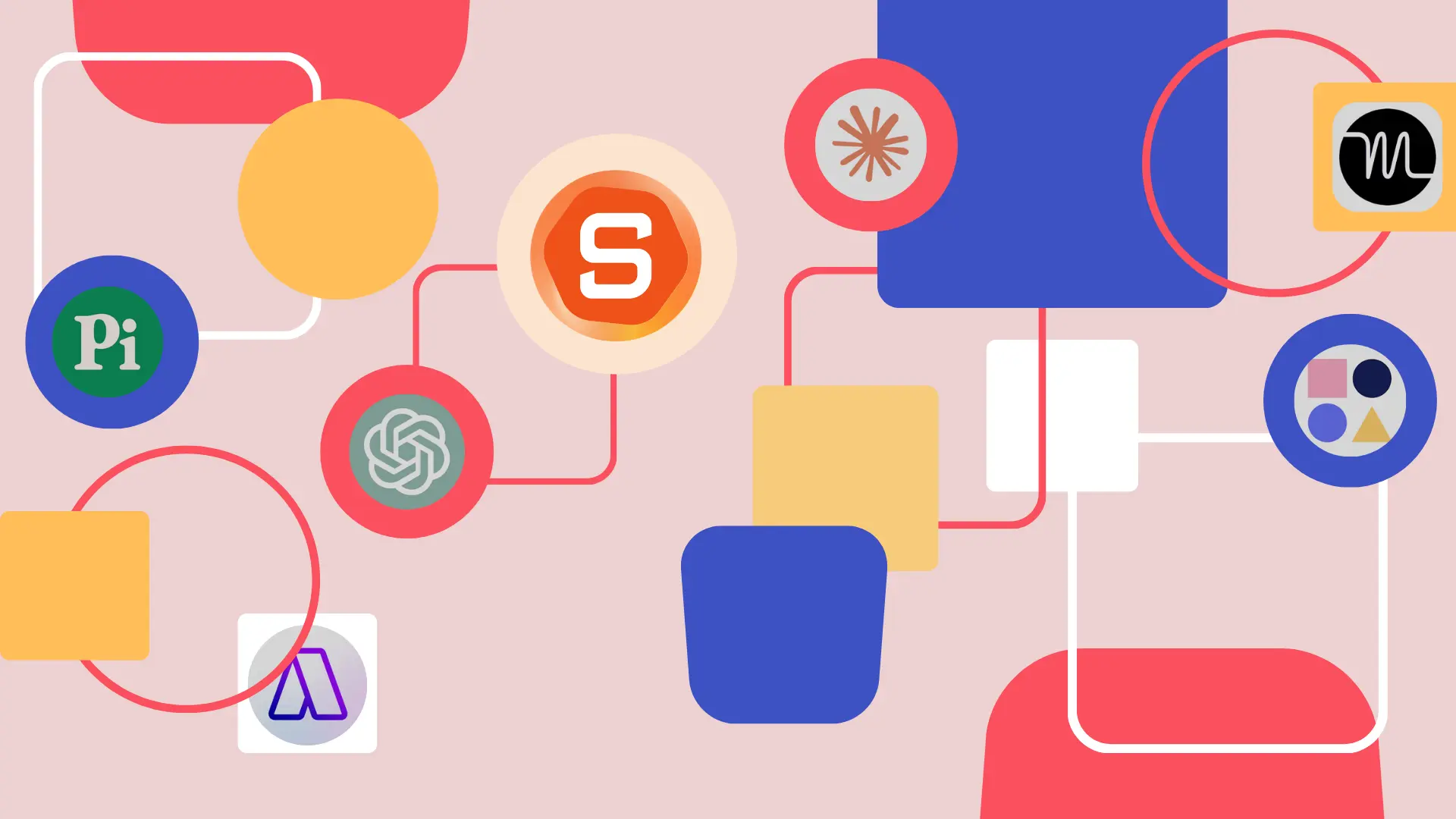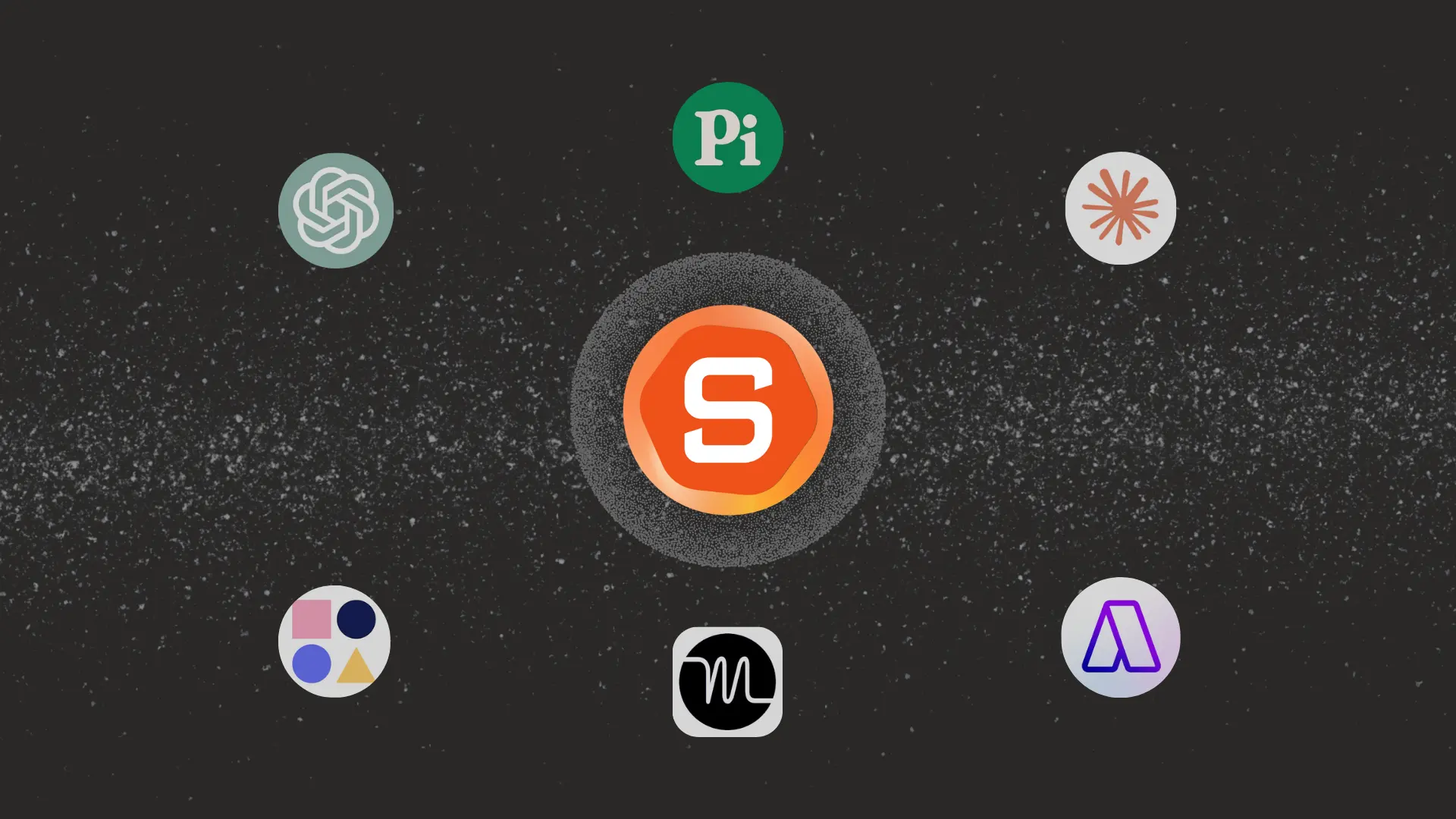How to built a Personal GPT and x10 your productivity
Ever felt overwhelmed juggling multiple tasks, emails, and notes scattered everywhere? You’re not alone.
In this post, we will look into personal GPT – a custom AI assistant tailored specifically to your context, tasks, and preferences. A personal GPT understands your workflow, remembers past interactions, and becomes an indispensable helper in your daily routine.
1. What Is a Personal GPT?
A personal GPT is a customized version of a large language model that is tailored to your needs. Unlike generic chatbots, a personal GPT can:
- Remember your preferences and writing style
- Understand your recurring tasks and data
- Help you with specialized topics (e.g., grant writing, ADHD coaching, startup workflows)
Think of it like an AI-powered executive assistant that you train and tweak over time.
Imagine having an AI:
- For marketers: that instantly suggests campaign ideas based on your past successful projects.
- For researchers: that synthesizes insights across numerous papers instantly.
- For entrepreneurs: helping streamline tasks, manage your calendar, and prioritize emails automatically.
How It Differs from ChatGPT or Gemini
| Feature | ChatGPT/Gemini | Personal GPT |
|---|---|---|
| General memory | ✅ Limited | ✅ Custom & deep |
| Personalized workflows | ❌ | ✅ Tailored |
| Private file training | ❌ | ✅ Possible |
| Long-term memory | ❌ (limited) | ✅ Persistent across sessions |
2. Why Personal GPTs Are Becoming Popular

Personal GPTs reflect a broader shift towards AI personalization and productivity enhancement.
- According to Gartner, by 2028, over 20% of workplace apps will use AI-driven personalization algorithms to create adaptive worker experiences, which enhance productivity by tailoring tasks and automating workflows based on individual work styles
- McKinsey reports that employees are increasingly using generative AI for a substantial portion of their daily tasks, with expectations that this adoption will grow significantly within a few years
People increasingly value AI that understands their unique context, driving adoption rates up and transforming everyday tasks into manageable routines.
3. Best Tools to Build a Personal GPT (and How to Use Them)
Here’s a breakdown of the top tools to create your own personal GPT, with how to use them and what works (or doesn’t):
🧠 Comparison Table
| Tool | Best For | Pros | Cons |
|---|---|---|---|
| OpenAI Custom GPTs | General users, writing | No-code, file upload, GPT-4 power | No memory, usage caps |
| Saner.AI | Productivity, ADHD users | Tasks + files + reminders + auto-org | New, needs internet |
| ChatGPT+ Memory | Everyday conversations | Set-and-forget personalization | Memory can be inconsistent |
| Replit Ghostwriter | Developers | Deep code integration | Not beginner-friendly |
| LM Studio | Privacy-conscious users | Fully offline, private models | Technical setup required |
| Poe | Mobile + quick prototyping | Fast bot creation, model variety | No true memory or file upload support |
1. OpenAI Custom GPTs
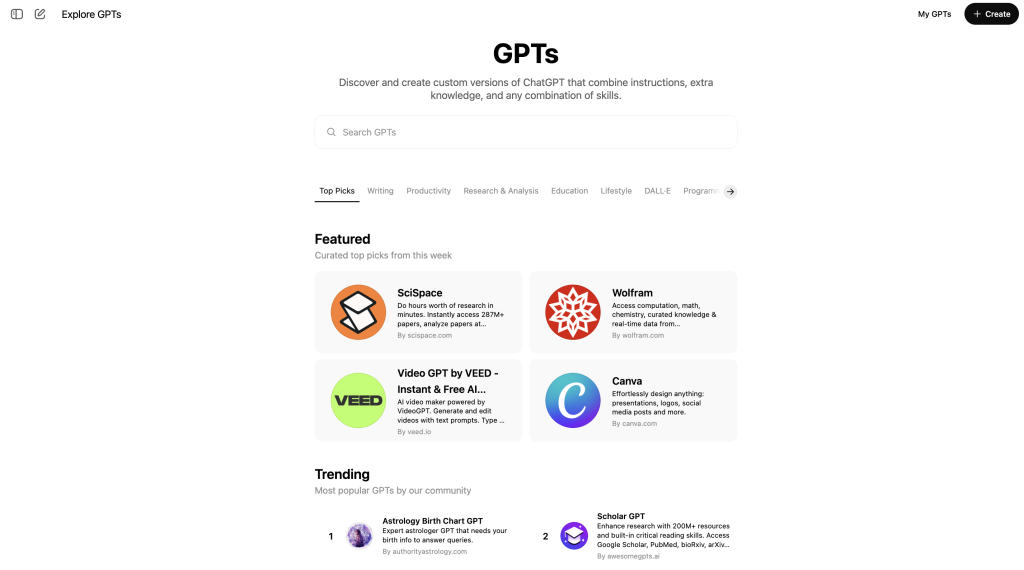
For building your own GPT inside ChatGPT (no coding needed)
How to Use:
- Go to ChatGPT > Explore GPTs (requires ChatGPT Plus).
- Click “Create” to launch the Custom GPT builder.
- Follow the wizard to:
- Write system instructions (e.g., “Act like my productivity coach”).
- Upload files (like notes, writing samples, or SOPs).
- Add custom APIs or actions (if you want advanced features).
- Save it. You now have your own GPT with a custom name and prompt style.
What I Like:
- ✅ Zero-code interface — very friendly for non-tech users.
- ✅ Can upload files, URLs, and define behavior and tone.
- ✅ Uses the most capable LLMs available.
- ✅ Easy sharing or keeping it private.
What I Don’t Like:
- ❌ Limited long-term memory — doesn’t persist between sessions unless data is in a file or prompt.
- ❌ No task or calendar integration — not a true assistant, more like a smart chatbot.
- ❌ Usage is still gated behind ChatGPT Plus ($20/month) — and heavy use can run into token limits.
2. Saner.AI
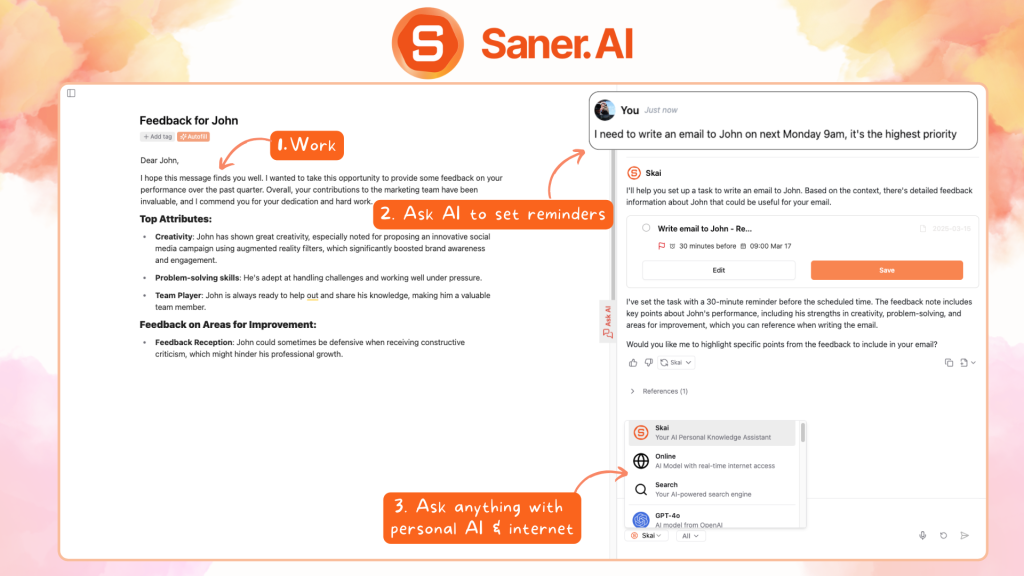
Designed specifically for busy professionals, Saner acts as a smart personal assistant that unifies your notes, emails, and documents – and lets you ask AI anything across them.
How to Use:
- Sign up at Saner.AI
- Connect your Gmail, Google Docs, and upload your notes or files.
- Talk to the AI — it will extract tasks, set reminders, and suggest next steps.
- Ask things like:
- “What should I prioritize this week?”
- “Summarize insights from my project notes.”
- “Turn this email into a to-do.”
What I Like:
- ✅ Combines note-taking, email, calendar, and task planning into one AI-powered inbox.
- ✅ Especially useful for people with ADHD or executive overload.
- ✅ Understands messy language and breaks it into actionable tasks.
- ✅ Memory works across tools and files — not just chat.
What I Don’t Like:
- ❌ Newer product – some advanced features are still evolving.
Saner.AI Reviews

Pricing
- Free
- Starter: Monthly at $8/month, Annually at $6/month (with early user discount)
- Standard: Monthly at $16/month, Annually at $12/month (with early user discount)
Who is it suitable for?
Saner.AI is particularly well-suited for:
- Intensive knowledge workers who need to manage large amounts of information efficiently from multiple sources, such as entrepreneurs, researchers, managers, and content creators
- Individuals with ADHD or those who struggle with information organization and time management
- Anyone looking to streamline their workflow without spending too much time learning a new tool.
How to start using it?
- Visit the Saner.AI website and sign up for an account
- Explore the app’s features, starting with basic note-taking and task creation.
- Check out the 1-min tutorial here
3. ChatGPT+ Memory
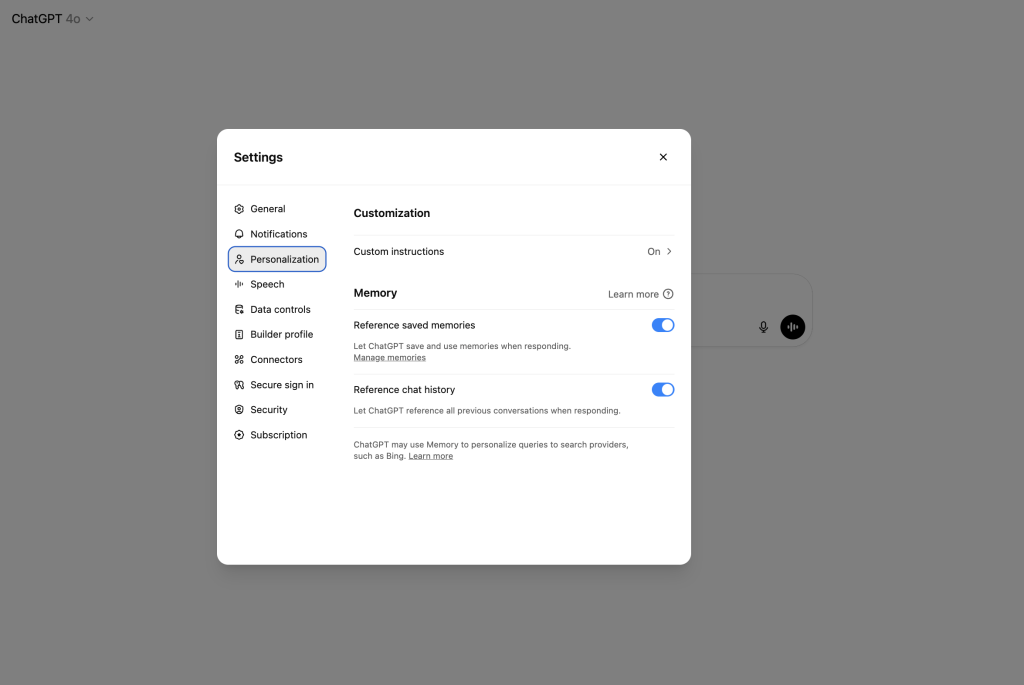
For lightweight personalization inside regular ChatGPT chats
How to Use:
- Go to Settings > Personalization > Enable “Memory.”
- Start chatting. GPT will begin remembering preferences like:
- Your name and tone
- Projects you’re working on
- Writing or formatting styles
- You can manage or delete memory anytime from Settings.
What I Like:
- ✅ Super simple — just turn it on and chat.
- ✅ Remembers facts and style over time.
- ✅ Great for recurring tasks (e.g., daily writing, brainstorming).
What I Don’t Like:
- ❌ Memory is limited — can forget details or get fuzzy.
- ❌ Not good for complex or structured workflows (e.g., project planning).
4. Real Use Cases for Personal GPTs
- Knowledge Workers: A GPT summarizing extensive research into actionable insights instantly.
- Entrepreneurs: Automating email triage, task planning, and reminding you of critical follow-ups.
- People with ADHD: Personal GPT turning rants or scattered thoughts into structured tasks with timely reminders.
5. Conclusion / TL;DR
A personal GPT is your own custom AI assistant that understands your context, tasks, and workflows.
It enhances productivity, reduces cognitive load, and simplifies daily tasks.
Top platforms include OpenAI’s Custom GPT, Saner.ai, and GPTs on Poe. Perfect for knowledge workers, entrepreneurs, and those needing structured support.
6. Frequently Asked Questions (FAQs)
1. What is a Personal GPT?
A Personal GPT is an AI-powered assistant designed to help you manage your day-to-day tasks through natural conversation. Think of it as your custom AI brain—you can chat with it to schedule tasks, search notes, summarize meetings, or draft emails.
Instead of clicking through menus, just say things like:
- “Remind me to follow up with Alex tomorrow”
- “Summarize today’s standup”
- “Find my Q3 roadmap notes”
Popular Personal GPTs include Saner.AI, ChatGPT, and Gemini, each built for different productivity needs—from note retrieval to calendar automation.
2. What can a Personal GPT do?
A well-built Personal GPT acts like an always-on assistant for busy minds. Key capabilities include:
- Task from text – Converts ideas or messages into actionable tasks
- Instant search – Finds notes or files using what you meant, not what you typed
- Smart scheduling – Books focus time or meetings on your calendar
- Meeting prep – Surfaces relevant notes and action items fast
- Writing help – Summarizes info, generates drafts, and ideates content
- Daily planning – Suggests priorities based on your current workload
Tools like Saner.AI combine all of this into one calm, distraction-free workspace – ideal for fast-moving professionals.
3. Are there free Personal GPTs?
Yes – many Personal GPT tools offer free plans to get started:
- Saner.AI – Free plan includes AI task reminders, calendar sync, and natural language note search
- ChatGPT – Free with GPT-3.5 access
- Gemini – Free via Google Workspace
4. How do I start using a Personal GPT?
Start simple. Use your Personal GPT to:
- Remind you of tasks you often forget
- Summarize long emails or documents
- Pull up past notes with one question
- Once comfortable, you can expand to scheduling, planning, and full task workflows.
5. What’s the best Personal GPT for ADHD?
Saner.AI is especially helpful for ADHD users. It reduces context switching, organizes your thoughts into actions, and keeps you on track without relying on complicated systems or tags.
6. Which Personal GPT is best for work?
If you want more than chat replies, Saner.AI is built for action:
- Combines notes, calendar, and tasks in one place
- Understands what matters and reminds you at the right time
- Helps you follow through—not just brainstorm
Great for professionals who juggle multiple projects and hate fragmented workflows.
7. Do Personal GPTs actually improve productivity?
Yes—by reducing app switching and mental load. For example:
- Saner.AI surfaces the right task at the right time
- Understands your notes, even when they’re messy
- Breaks big goals into bite-sized next steps
8. Do Personal GPTs support voice commands?
Some do. Here’s a quick breakdown:
- Saner.AI – Yes, supports voice-to-task input
- ChatGPT / Gemini – Voice via third-party integrations
9. Which Personal GPTs can auto-schedule tasks?
Three great options:
- Saner.AI – Understands your notes, priorities, and chats to suggest the best time slots
- Reclaim – Uses dynamic time blocking from your calendar
- Motion – Auto-schedules based on priority and availability
Saner offers a more personalized, context-aware approach than basic calendar shuffling.
10. Best Personal GPT for entrepreneurs?
Saner.AI is ideal for founders and solo operators:
- Turns messy brain dumps into clear tasks
- Connects notes, emails, and calendar in one space
- Surfaces old investor notes when planning new pitches
- No setup needed—just start working
11. How can managers use a Personal GPT?
Managers deal with task overload and mental juggling. A Personal GPT can:
- Remind you of follow-ups from team meetings
- Pull up relevant documents before your next 1:1
- Summarize long updates or email chains
- Help prioritize what matters (and filter what doesn’t)
With Saner.AI, you manage people—not tools.
12. How can CEOs use a Personal GPT?
For executives, time and clarity are everything. A Personal GPT can:
- Centralize access to decisions, notes, and follow-ups
- Nudge you to follow through on key conversations
- Help manage cross-functional goals and OKRs
- Cut down on time spent organizing, so you can focus on strategy
Saner.AI acts like a command center for your brain.
13. Can a Personal GPT help with meeting prep?
Absolutely. It’s like having a researcher on call.
With tools like Saner.AI, just ask:
- “What did we decide in last week’s product review?”
- “What’s still pending from the team sync?”
It pulls up everything—tasks, notes, context—so you walk in clear and confident.
14. What’s the best Personal GPT for executives?
Saner.AI stands out for senior leaders. Why?
- Connects tasks, calendar, and notes so you never lose the thread
- Surfaces high-priority items automatically
- Keeps your brain decluttered—everything’s in one place
Unlike point solutions like Reclaim or Gemini, Saner brings the full picture together.
15. How is a Personal GPT different from traditional productivity tools?
Think of it this way:
- Traditional tools = filing cabinets. You organize them.
- Personal GPTs = smart assistants. They organize for you.
With Saner.AI, you write notes naturally, and it:
- Tag and file things automatically
- Reminds you what matters, when it matters
- Let’s you ask one question instead of opening five apps
Your system finally works for you, not the other way around.

